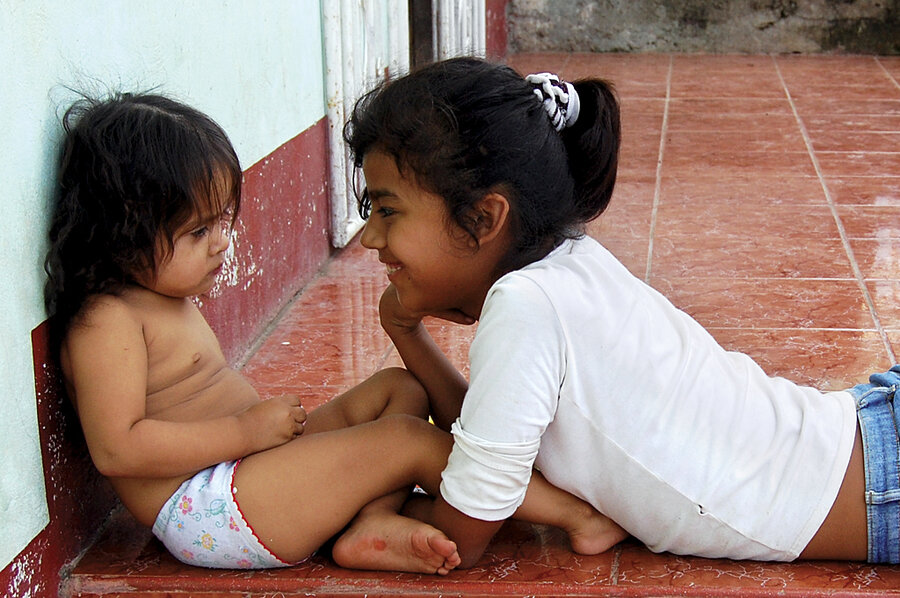Fourteen under one roof
Loading...
Living with eight children means that inevitably someone cries out at night. In San Juan de Oriente, this tiny town south of the Nicaraguan capital, Managua, they sleep two or three to a bed, and their bad dreams often wake the others. Usually it's the youngest, Alé, nearly 2, who has a rough time of it even when she's awake. Her mother shushes her in the night, mumbling and begging, "Why won't you sleep?"
When my boyfriend, Jonah, and I first move into the two-level house to work with the ceramic artisans in this town of 2,100, we aren't even sure how many people live in our house. We are helping the artisans build a website and teaching them basic business English. We throw in spirited English classes for their kids in Papa Alfredo's pottery workshop every night from 7 to 8 p.m., and that's where we do most of our laughing.
In one of our first classes, we ask all of the kids to draw pictures of their family for homework. We practice numbers, and they count how many people live in their homes. We know that Nicaraguan families run large. Four of our kids from the house we live in insist there are 14 people in their family, and we spend the week trying to figure out who actually lives with us, and who is just passing through.
There's Nancy and Alfredo, the mother and father; two grandparents; eight kids, ages 19, 15, 13, 13, 10, 9, 7, and 2; and two more unaccounted for, whom we assume we'll meet in the days to come.
The name we learn first is Alé, the 2-year-old, the difficult one, who runs and hides when she sees us. She likes things and people to be in their place, screaming rhythmically when she doesn't see her parents, or when someone moves her favorite one-armed doll.
She is unsure what to think of us – Jonah, tall and blond, and me, mixed-Asian with boisterous gestures. But then, one day when Jonah is on the second floor, she runs to me – her eyebrows high and her eyes wide – frantically saying, "tss-tss" (a sound made in Nicaragua to get someone's attention) and pointing up the stairs.
"Jonas esta arriba?" I ask if he's upstairs, and she nods emphatically.
It's as if she thinks something terrible will happen if Jonah and I aren't together, that we will stop breathing, or crumble on the floor, or burst into screamy tears the way she does. He and I are nearly always by each other's side and I begin to feel more comfortable in his presence than out of it. His Spanish is better than mine and I turn to him for words, cobbling together sentences with my vocabulary and his, borrowing verb tenses and local sayings that he easily picks up. We start dropping our s's the way Nicaraguans do.
Plus the dependency is a natural fit to the gender roles in Nicaragua. Men always turn to Jonah to introduce themselves or to ask questions or, at a crowded dance in the finca, the countryside, for permission to dance with me.
Among our Nicaraguan friends there are constant discussions about when and if we will get married and when and if we will have children. The discussions lean heavily on the when. Nancy, the mother of the house, offers a few of her own children to take home in the meantime.
"Don't you want to take Isaura back to the US?" she asks, and I lunge for the 7-year-old girl with a "Que bueno!" as she squirms and yelps, "No, no, no, no, no!"
The artisans egg us on, saying we should conceive a child in Nicaragua, so it can be, like their pottery, "Made in Nicaragua." On a few occasions, men warn Jonah that he should marry me quickly or another man will step in.
It's easier to nod yes and laugh along with them and make promises to invite them to our fictional wedding, and to return to Nicaragua in five years with five kids.
But the truth is that living in this house feels like family. Neither of us is from a large family and we love the way all of the kids take care of one another. We love how everyone pitches in and how there are no favorites.
We play stickball daily with the kids in the street; we chase the little one when she takes off running. We teach the kids to sing "We Are the World," and repeat inside jokes, cracking each other up with just a line.
When we finally collect the assignments of the children's family portraits, we see that the two missing people in the house were the two of us, their tia and tio, aunt and uncle.





